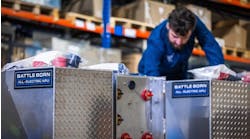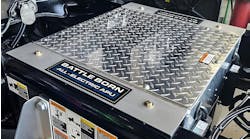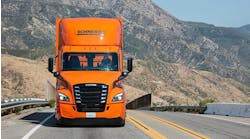The calculus of fuel efficiency has changed. The new math fleets can employ in the face of rapidly mounting diesel prices may not come in handy forever but it sure will this year, not to mention for the foreseeable future.
Described as the “Fuel Price Crisis” by the American Trucking Assns. (ATA), the run-up in diesel fuel prices shows no sign of abating — forcing the hands of fleet owners to consider all methods of boosting fuel efficiency.
Indeed, ATA has flat out declared that trucking is “experiencing the highest prolonged fuel prices in history.” ATA president and CEO Bill Graves summed up the crisis pointedly in a March 20th letter he addressed to President Bush: “Historically, diesel was the second-highest operating expense after labor for motor carriers. However, for many carriers fuel has now surpassed labor as their largest expense. This is a new development.”
In full agreement with that assessment is Dennis Morgan, COO of Cowan Systems, a truckload carrier operating mainly east of the Mississippi. “For the last 20 years, drivers were our number one cost,” says Morgan. “This year, however, it is fuel. And at $4 a gallon, it creates a real issue for our fleet operation. You never cover the entire added cost of fuel, even with surcharges, and you never recoup the cost of empty or deadhead miles. The spread between what is covered and what's not continues to grow as the price of fuel rises.”
Fuel's headlong rush to the top of everyone's list requires new thinking — starting with what can be done right away to knock down fuel expenditures as well as what can be done in the longer term to lift fuel efficiency above where it is today for most fleets.
Adjusting or even rewriting truck specs, adding aerodynamic, anti-idling and other fuel-saving devices, making greater use of software, and seeking to better train and educate drivers, are all key avenues to deflecting the bite fuel is taking out of the operating budget.
Roll back
Among the first this year to make a big — and public change — to boost mpg were the sister Con-way Freight and Con-Way Truckload fleets.
As it happens, ten days before Gov. Graves' letter to the White House, Con-way Freight, the LTL fleet, announced it had dialed back the speed governors on its 8,400 tractors to improve fuel conservation and reduce carbon emissions. The carrier adjusted the governors so engines ran at a maximum of 62 mpg — down 3 mph from the previous top speed.
Con-way expects that move alone to cut diesel fuel use by nearly 3.2 million gal. annually while removing some 72 million lbs. of carbon emissions from the air, which, of course, will help put the shine on the company's green credentials.
According to Con-way spokesman Gary Frantz, even with the run-up in diesel prices, as an LTL operation, Con-way Freight's “people and facilities remain a larger cost than fuel. But when you use 110 million gal. a year, anything you do to save fuel amounts to some serious money pretty quickly.”
Frantz says the 3-mph drop will cut the fleets' fuel use by 3.2 million gal. a year. “Depending on the tractor,” he advises, “so far we are seeing a two- to three-tenths of an mpg improvement from just this change alone.” He notes the fleet began adjusting its 8,400 tractors and straight trucks in December and completed the campaign in January.
Frantz advises that the change has been “going over as well as we hoped with drivers.” He says the biggest impact was on operations. “Over the same runs, drivers may be on the road 20 to 30 minutes longer but our highly engineered network can handle that. It just means being more diligent at the dock. A key thing is we have done this with no degradation of our on-time performance.”
He points out that Con-way Freight had already implemented such emissions-saving moves as spec'ing aerodynamic fairings, using special engine and transmission lubricants and minimizing idling time.
Wide ones
Not to be outdone, Con-way Truckload (which includes the former Contract Freighters Inc. fleet) has been cutting its top speed down from 70 to 65 mph, relates Bruce Stockton, vp of maintenance and asset management. “Back before Con-way bought us, we, at Contract Freighters, had started a campaign to change our fleet speed to save fuel,” he explains.
“We actually started back in October '06 by first just talking to our drivers to encourage them to slow down to improve mpg, but we knew we'd have to do it [change governed speed] sooner or later. Still, it helped to have drivers see that no company could continue to pay $3.50 and up for diesel.”
Stockton says that when a new driver pay package was rolled out, the carrier figured that was the best time to cut road speed as part of the deal as it were — but it made sure to explain all this to drivers.
“We told them we knew there was inconvenience from running a little longer to get from Point A to Point B so we were willing to share the gains with them by way of the pay increase — a penny more a mile — that took effect this January,” he remarks. “Of course, fuel has gone up at such a drastic rate this year the company savings will not be as high as projected.”
Like its LTL sister, Con-way Truckload has not seen its transit times affected by the lower speed. “When the average haul is 1,100 mi. over two days, the drivers may end up behind the wheel a few more minutes, that's all. And 65 is a safer speed for them to be at,” says Stockton.
Other fuel-smart changes made at the truckload operation over the past three or four years include a switchover to Michelin wide-base tires in place of single duals.
With the tractor fleet 100% on wide-base tires and the trailers about half converted, Con-way Truckload is enjoying a dividend of two-tenths an mpg when the tractors roll on “wides” and half an mpg when the whole rig does.
“The more tires that come on, the faster the return on investment [ROI],” says Stockton. “It depends on how you do it. We converted via our trade cycle — not all at once. But we figure putting these tires on 2,700 trucks with fuel at $3.65 a gallon saves us $2 million annually.”
Stockton notes that managers “have been dealing with the drivers' perception of wide tires since 2003.” He says now that the tires are more readily available that is less of an issue, and a side benefit is “they are more likely to check inflation now and, with duals, that is easier to do as well. Once we had about 60% fitted, we saw the drivers' anxiety fall off.”
The fleet has used cab heaters since '05 and is now looking at battery/electric-powered systems to provide cab cooling if not heating as well, advises Stockton.
“We're also always working to trim vehicle weight,” he points out. “We've cut 673 lbs. out of our newest trucks.” Much of that savings was gained by switching from dual 120- to 100-gal. tanks. “We did not need the capacity; besides the tank weight, each gallon of diesel weighs 7 to 8 lbs.”
Another weight cut comes thanks to the fleet's 2007 engines. Stockton says because these engines run so clean there is no concern about exhausting them near the sleeper, so horizontal rather than vertical stacks can be spec'd — saving 80 lbs. that helps offset the heavier weight of these engines.
Stockton adds that he thinks “something else that will really help will be to find a navigation system with true truck routing. There'd be some payback there; fuel gets used due to truckers being lost.”
Smart buys
Cowan Systems' COO Dennis Morgan says the truckload fleet of 80 company-owned trucks has been “trying to fuel smarter.” That includes buying bulk fuel for terminals and negotiating with truckstops for volume discounts.
“Bulk fuel purchases save us 10 to 15 cents off the street price of fuel,” says Morgan. “We've stayed away from fuel hedging. It seems like too much of a guessing game. Instead we're trying to cut down on empty miles and out of route miles via more focused route management on our part. We're testing software right now that maps out the most fuel-efficient routes for our trucks and overlays the lowest price diesel fuel stops over those routes. We've shied away from such software in the past, but with the price of fuel the way it is, we're looking at everything.”
Data rich
C.N. Brown operates 87 Big Apple Food Stores and 32 Red Shield heating oil outlets in New England and also delivers fuel to over 100 independent service stations in the region. Hauling the stuff doesn't make it cheaper to fuel up the 20-tractor petroleum tanker fleet, but some relief has been gained thanks to management software.
“At first, our fleet management [software] effort was about compliance. But we've since come to realize it's really about efficiency,” says transportation manager Ken Cannell of the fleet's use of a Cadec Mobius TTS system integrated with a custom supplier payment system. “Because we're hauling regulated materials, we have to know the whereabouts of each truck, the details of each stop, and drivers' hours of service.”
Cannell says a big dividend of all this automation has been reduced fuel consumption. “The Cadec system lets us monitor and reduce idle time,” he explains. “That directly impacts the amount of fuel used.”
He estimates that even with increases in fuel and operating costs as well as an additional 90,000 mi. traveled in 2007, C.N. Brown cut its overall fleet cost by 3 cents per mile compared to 2006 — for a total savings of about $60,000 — just by leveraging software.
That leveraging in large measure came through educating and counseling drivers using information generated by the Cadec system and by using that data to reduce the fleet size by several tractors over the past two years, according to Cannell.
Smart specs
Jeff Bryant, vp of maintenance for truckload carrier Celadon, says one of the fleet's biggest efforts to boost mpg right now involves very seriously counseling drivers on idle time. “We are emphasizing to our top idlers — the 3 to 5% of drivers who are the worst offenders — that if they can't improve, we will have to part ways. The truth is we can't afford to keep them.”
While Bryant recognizes the immediate and powerful impact drivers have on fuel economy, he is also giving serious consideration to every spec change that could boost mpg. And that begins with the tractor trade cycle, which he has “sped up” to get more familiar with the new technology as quickly as possible.
Bryant notes that Celadon has the industry's “largest standing order” for International ProStars powered by Cummins ISX engines and only “brings in the most aerodynamic tractors as certified by SmartWay, including ProStars and Freightliner Cascadias and Volvo VNs.”
Faster trading also means fuel-efficient specs can come into play faster. “These new trucks are being outfitted with side skirts for the first time,” reports Bryant. “We hadn't been using them due to the cost of repair after an accident, but the 1 to 2% mpg gain they provide is now worth the cost.”
Celadon is also now outfitting tractors with Espar auxiliary cab heaters to cut idling. “We worked at finding the best way to handle idling,” relates Bryant.
“We wound up adding ambient temperature sensors so the heater works between 20 and 70 degrees,” he continues. “We are still asking the drivers to use their best judgment; below 20, they can run the tractor engine as needed.
“With diesel at $4, this is providing an immediate payback,” states Bryant. “But at this point, we don't know if the payback will be there for an APU-type cab cooling system.”
While Bryant says Celadon remains concerned about the serviceability aspect of wide-base tires, the fleet is very happy with a “highly fuel-efficient tread compound in a Goodyear product we feel closes the gap between standard duals and wide-base tires for fuel economy. We've been running these tires for three years, and we're realizing a 6% mpg improvement over standard premium dual drive tires.”
But wait, there's more. Celadon has also reduced the top speed of its trucks by 2 mph. “There was a reaction by drivers, of course,” Bryant advises matter of factly. “But we presented it to them as a team effort.”
Celadon did add a sort of sweetener. Through the wonders of electronic engine controls, “drivers who accomplish their base fuel economy requirement can still run at 63 to 66 mph. Such practices as using cruise and staying in top gear, even not overusing the defroster, will get them there.”
Bryant notes that drivers are instructed that they are responsible for 15 to 20% of their mpg performance, and engine data is used to counsel them on driving habits.
“All the changes we have made together have produced a savings of approximately $1.6 million in just the last quarter,” Bryant reports.
Straight talk
According to Todd Renehan, Ryder's executive vp-sales and marketing, fleet management solutions, there are several very straightforward steps fleets can take to boost mpg.
At the top of his list: driver training. “The driver still has the largest impact on fuel economy, and speed is the largest single factor,” he states. “Just reducing speed from 65 to 55 can improve mpg as much as 22%.”
He says whatever top speed a fleet ultimately moves to — 55 or 62 or just 65 — should be determined as part of a business decision that takes into account not only the drivers' contribution but routing and scheduling as well.
Fuel-efficient moves he points to that can be made more readily include proper tire maintenance; disciplined preventive maintenance; spec'ing fuel-efficient equipment on new trucks; and leveraging such new technology as telematics to keep track of idle time as well as to manage other aspects of driver and vehicle performance.
If vehicles are leased, Renehan says the fleet should be able to get fuel efficiency ROI calculations for various specs from their lessor. If not, he advises contacting the specific OEM or component maker.
Doing the math
Many ROI calculators are now posted free of charge online by manufacturers via links at their home sites. Another option is to punch figures into the EPA's SmartWay “Technology Package Savings Calculator” accessed at www.epa.gov/smartway. All this new math may take getting used to but to be sure, there's no getting around it.


